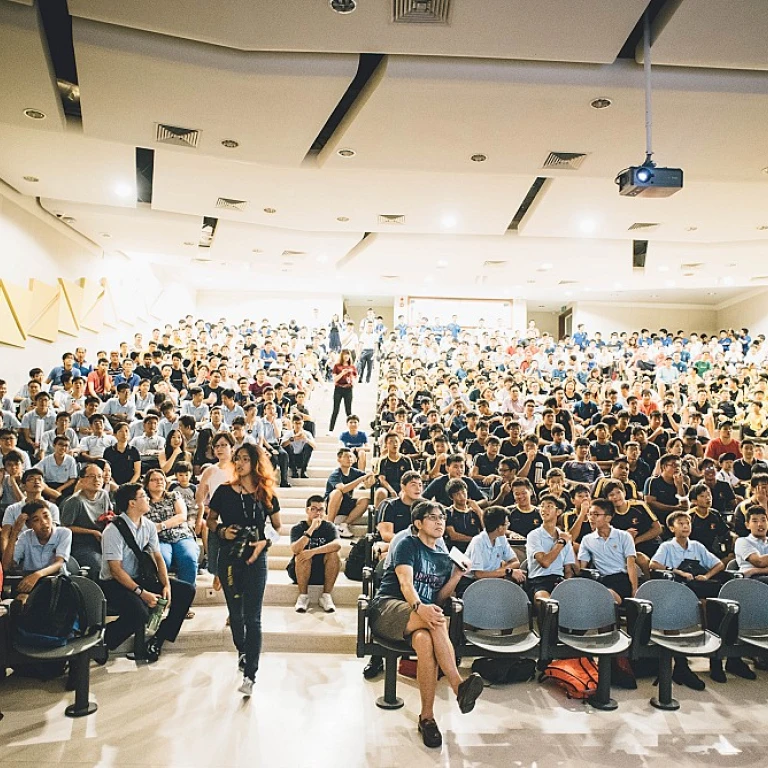
Understanding Virtual Learning Environments
A Closer Look at Virtual Learning Platforms
In today's fast-paced world, virtual learning environments (VLEs) have become an essential tool for students and teachers alike. Whether you are part of a university, involved in distance education or using online platforms for self-paced studies, VLEs have made online learning more accessible and dynamic. Virtual learning offers a unique understanding of how students and teachers interact in an online classroom. These digital platforms serve as hubs for course materials, discussions, and assignments. Unlike traditional classrooms, virtual learning operates in real time, allowing students and teachers to connect through video conferencing and other digital tools. The technology behind VLEs often includes learning management systems (LMS). These platforms provide a structured environment where education is systematically managed. VLEs are not just about lesson plans and assignments—they integrate multimedia content, discussion forums, and assessments to create a holistic learning experience. One example of this technological shift was during the COVID pandemic, when schools worldwide turned to VLEs to continue education without interruption. It opened a new chapter in teaching and learning, showing how technology can play a pivotal role in education. From open source systems to custom-built environments, the options are vast and varied. With VLEs, students gain more control over their learning, fitting education into their busy schedules. Teachers can customize content to match student needs, improving engagement and effectiveness. From primary schools to higher education, these systems have made learning more personalized and flexible. Yet, the shift to virtual classrooms isn't only about convenience—it's about expanding educational opportunities. Now, students can access courses and resources from universities around the world, increasing the breadth of learning experiences available to them. As we continue to embrace these advancements, VLEs are set to enrich education in countless ways.Benefits of Virtual Learning Environments for Continuous Learners
Advantages of Virtual Learning Spaces for Continuous Learners
Virtual learning environments bring a fresh breeze to the education scene, especially for students committed to continuous learning. No longer bound by location or traditional class schedules, learners can now soak up knowledge in their own time, at their own pace.- Personalized Training: With virtual setups, students get courses crafted to match their learning speed and style. This means a more personalized learning experience where students can truly grasp content without unnecessary pressure.
- Flexible Timer Saver: For those balancing work, family, and studies, virtual systems offer flexibility that traditional classrooms can’t match. Learners can schedule their studies around their lives, not the other way around.
- Vast Resources at Your Fingertips: From expertly curated video content to comprehensive infographics, VLEs provide a treasure of educational materials. This access ensures students are never short of resources when preparing for exams or projects.
- Global Reach: Virtual classrooms open doors to global access. Students can join courses from renowned universities and engage with teachers from around the world, making world-class education a click away.
Tech Necessities to Level Up Virtual Learning
To make virtual learning more engaging and effective, tech tools play a crucial role. Consider these tangible aspects of a productive VLE:- Learning Management Systems (LMS): An efficient LMS acts as the backbone for any good virtual setup. It organizes courses, tracks progress, and provides analytics for both teachers and students.
- Video Conferencing Tech: Tools like Zoom have become synonymous with virtual classrooms. They allow real-time interaction between students and teachers, fostering a sense of community in an otherwise isolated online environment.
- Open Source Platforms: Picking open source platforms for learning environments can offer customization that suits individual or institutional needs. They offer flexibility and innovation that come with community-driven improvements.
- Engagement Tools: Incorporating quizzes and discussion forums in LMS can spur student engagement. A break from standard lectures, these tools invite students to interact dynamically with the content and their peers.
Challenges Faced in Virtual Learning Environments
Obstacles and Realities of Learning Online
Virtual learning environments (VLEs) promise a learner-friendly experience, yet it's not without hurdles. Students and teachers alike face several barriers when embracing online education, especially during the transition phases. Firstly, the emotional disconnect in a VLE is palpable. In a typical classroom, student engagement is natural. Eyes meet, voices echo, and spontaneous conversations spark learning. But online, how do you maintain that same vibe? Despite the best efforts of video conferencing tools, the personal touch often feels missing. The absence of facial cues and real-time interactions can make students feel like they're in a bubble, impacting their learning experience. Then there's the dreaded technology glitch. Anyone who’s been in an online meeting knows the pain of a poor internet connection. Time lags, unfriendly user interfaces, and LMS (Learning Management Systems) that crash mid-course are obstacles that everyone eventually encounters. Such experiences can be particularly disrupting, often feeling like the virtual system has let you down. Students and teachers must also wrestle with the weight of distractions at home. From noisy pets to nearby TV shows, keeping focused during an online course can be mentally taxing. The boundary between home and VLE turns blurrier, and it's challenging to find a set routine. Moreover, the digital divide is another elephant in the room. Not everyone has access to the latest technology or high-speed internet, positioning some students at a disadvantage. This is especially evident in distance education settings and during the COVID pandemic, where many have been left wanting for resources that support virtual learning. Educational institutions must support their students by establishing a robust support system. This could include offering training sessions for both students and teachers to navigate the online environment with ease. Universities can also explore open source platforms which often provide more flexibility and cost-efficiency in virtual classrooms. Balancing these challenges while aiming for success in online learning is a bit like tightrope walking. It calls for strategic use of time management skills, adaptation to the virtual learning environment, and leveraging available technological tools. Anyone willing to go the extra mile in VLEs will gradually develop resilience and a nuanced appreciation of this mode of learning. As we look to the future, it’s important to continuously refine our strategies and explore new technologies, keeping our learning environment as engaging and effective as possible. Embrace the resources available, like those mentioned in this continuous learning article, to further enhance the virtual learning adventures.Technological Tools Enhancing Virtual Learning
Tech Tools That Make Virtual Learning Tick
Virtual learning environments (VLEs) are more than just a digital classroom. They are a blend of various technological tools that create a seamless learning experience for students and teachers alike. Let's explore some of the technology that's making online learning more effective and engaging.
Learning Management Systems (LMS)
At the heart of most VLEs is the Learning Management System. An LMS is the backbone that manages, delivers, and tracks educational courses. Think of it as the control center where students access course materials, submit assignments, and engage with teachers. Popular systems like Moodle and Blackboard offer customizable features that cater to different educational needs. These systems help in organizing content, tracking student progress, and facilitating communication between students and teachers.
Video Conferencing Tools
When the COVID pandemic hit, video conferencing tools became the lifeline for education. Platforms like Zoom, Microsoft Teams, and Google Meet have become integral to the virtual classroom experience. They allow real-time interaction, making it possible for students to participate in live discussions, group projects, and even virtual office hours. This face-to-face interaction, albeit online, helps in maintaining student engagement and motivation.
Interactive Content Platforms
Gone are the days of static PDFs and PowerPoints. Today's VLEs thrive on interactive content platforms like H5P and Nearpod. These tools allow teachers to create engaging content that includes quizzes, videos, and interactive activities. By providing immediate feedback and allowing students to interact with the material, these platforms enhance the learning experience and make education more enjoyable.
Open Source Solutions
Open source tools are gaining traction in the education sector. They offer flexibility and cost-effectiveness, which is particularly beneficial for universities and institutions with limited budgets. Platforms like Open edX and Sakai provide robust solutions for creating and managing online courses, giving educators the freedom to modify and improve the system to fit their specific needs.
Mobile Learning Apps
With smartphones becoming ubiquitous, mobile learning apps are reshaping how students access education. Apps like Duolingo, Coursera, and Khan Academy offer on-the-go learning, allowing students to study anytime, anywhere. This flexibility is crucial for continuous learners who need to balance education with other commitments.
In the world of virtual learning, these technological tools are not just accessories; they are essential components that make the learning environment more efficient and accessible. As technology continues to evolve, so too will the ways we learn and teach online.
Strategies for Success in Virtual Learning Environments
Thriving in a Virtual Learning Environment
When it comes to online education, the experience can be as rewarding as traditional classrooms, especially if you have the right strategies. Let's look at practical ways students and teachers can make the most out of Virtual Learning Environments (VLEs).Firstly, carve out dedicated time for your courses. While the online format offers flexibility, it’s easy to let distractions creep in. Having a set schedule helps maintain a learning rhythm, making progress more consistent and less stressful.
Student engagement is vital. Active participation in virtual classrooms, whether through video conferencing or online discussions, keeps the momentum going. Not to mention, it fosters a sense of community with your peers, crucial during the COVID pandemic times.
For educators, creating a captivating learning environment is a game-changer. Mixing multimedia resources such as podcasts and videos can break the monotony and cater to different learning styles. Don't just rely on lectures; a varied approach keeps students engaged.
Making Technology Work for You
Technology is the backbone of any virtual learning system. Familiarize yourself with the Learning Management System (LMS) your university uses. Whether it’s open source or proprietary, knowing its features can enhance the overall learning experience. From tracking assignments to managing resources, a bit of system knowledge goes a long way.
For real-time collaboration, leverage tools like Google Docs or online whiteboards. They are invaluable for group tasks, providing a seamless interface that mimics shared spaces. Tools like these bridge the gap between distance education and the vibrancy of traditional settings.
Building Effective Learning Habits
Remember that virtual education isn't just about passively digesting information. Engage deeply with the material. Whether it’s higher education or a short course, putting thoughts into action solidifies learning. Write reflections, share insights with your classmates, and apply concepts to real-life situations.
Teachers can also benefit by receiving student feedback. Understanding what works and what doesn’t can guide future course designs and help adapt teaching methods. A two-way communication channel enhances the teaching-learning experience and builds trust.
In conclusion, success in a virtual learning environment extends beyond mastering the content. It's about building a structure that respects your time, enhances interaction, and leverages the strengths of the VLE. With the right approach, online learning holds the promise of personal and academic growth.
Future Trends in Virtual Learning Environments
Peeking into Tomorrow's Virtual Classrooms
The journey of learning is constantly shifting with technology. Virtual Learning Environments (VLEs) are reshaping how students and teachers connect, making online learning a staple in education. But what's on the horizon for these platforms?Rising Trends in Technology
Technology is at the heart of this evolution. Emerging tools stretch far beyond conventional setups, bringing real time engagement to students regardless of their location. Important shifts include:- Artificial Intelligence (AI): AI continues to personalize learning experiences by adapting content to individual student needs. Learning management systems (LMS) integrate AI to predict student performance and tailor educational resources.
- Virtual Reality (VR) and Augmented Reality (AR): These technologies bring courses to life by immersing students in simulated environments. Imagine attending a virtual university lecture that feels just like the real thing.
- Video Conferencing Evolution: Platforms have become far more interactive due to the COVID pandemic, offering features that closely mimic a traditional classroom setting.



